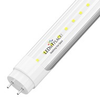If you are still using halogen lights instead of LED downlights in your workspace or personal space, you are perhaps doing a disservice to yourself. With halogen bulbs being banned by European Union, the retailers and homeowners got their halogen bulbs quickly replaced by LED downlights as these lights are far better in design and efficiency than the halogen lights. One of the most prominent reasons for the ban to finally come into effect was the extremely low energy-savings to ultimately cause a demand-fulfillment burden on the public utility companies of any nation. LED downlights also known as can lights or pot lights are recessed ceiling lights designed to emit light beam in a downward direction having major applications like kitchens, bathrooms, living rooms, dining halls etc.
In the first part of this blog, the focus will be laid on why halogen lights must be avoided while the second part will have information on LED downlights.

Halogen Lights: Why These Lights Must be Avoided?
The following are the most practical reasons as to why halogen lights must be avoided at all costs.
One of the major problems with halogen lights is omni-directional light beam. The light beam angle usually falls in the range of 40-60 degrees but larger halogen lamps can have 120 degrees but there will always be the need for reflectors for the light beam to be directed at intended areas and not go wasted.
The halogen utilizes a technology where the lamp needs to warm up and turn On. It is because of this that it consumes more power to produce the same amount of light as what you could expect from LED downlights utilizing less amount of energy. The power drawn by halogen lights is almost 5-6 times and so these lights turn out to be en energy-guzzler.
When speaking of environment-friendliness, halogen lights come to be known as one of the most non-eco-friendly lights because of high energy use by these lights and as a result high amount of carbon-dioxide emissions.
The halogen lights warm up too soon and need cooling down to remain in operation for a long time and this is why they can not be an instant-On at all times. Additionally, these lights may also flicker because of variation in voltage supply due to inept electronic circuitry. However, they flicker a lot lesser than the metal-halides or HPS lamps.
The light colors are better understood through CCTs (Correlated Color Temperatures) when the halogen lights do not offer a wide variety of choices as is offered by LED downlights. At the most, you can expect halogen lights to be in the color temperature range of 2800-3400K to emit a warm white light that is good for relaxation but not for tasking environment.
While the halogen lights may last for only 2,000 hours (much lesser than even metal-halides), the LED downlights can last for as long as 50,000 hours. With such a long lifespan, your bulb replacement costs come down. The lifespan may get extended if LED downlights are maintained well.
In a nutshell, halogen lights carry much more disadvantages than advantages. So, now, let’s get into the details of LED downlights.
LED Downlights: Why These Lights Are a Better Choice?
With the disadvantages of halogen lights so clearly mentioned, LED downlights do not need much details except for the part to be said that these lights have overcome all the demerits of halogen, thanks to the efforts made by the lighting researchers and designers. These lights are much more energy-efficient and can cut down your utility bills by up to 88%. The running costs too for these lights are much less and even though these may sound a bit expensive, the return on investment is much higher. Another very important merit of these lights is no light pollution and hence better protection and maintenance of the environment. The lights are directional and so no light gets wasted. Also, these lights never warm up unlike the halogen -- the excess heat being taken care of by the internal heat-sink. The light beam emitted is consistent, even and uniform with no hazardous chemicals or radiation. Further, these are available in more than one CCT such as 3000K (warm white), 4000K (neutral white) and 5000K (neutral white-daywhite) to allow for ambient, accent and display lighting. In color temperature of 5000K, you can also undertake short tasks that do not require much focus and precision.
Conclusion
With the details provided here, the only thing you must remember before you get prepared to purchase LED downlights as dimmable or non-dimmable is -- these downlights are generally used for ambient lighting and can be used in spaces (home or office) even when the spaces are full of congestion.


















































































